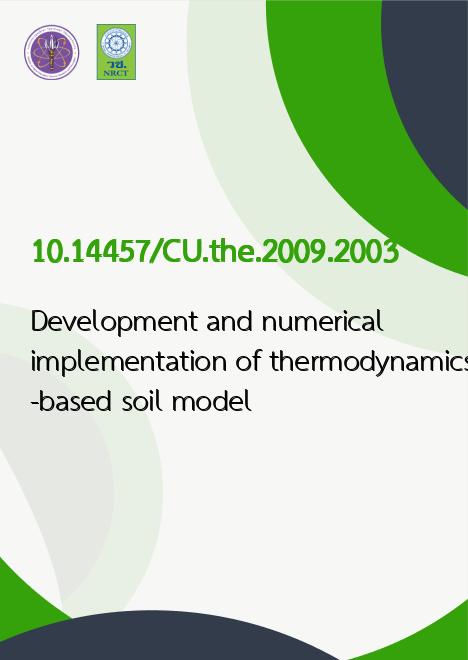
|
Development and numerical implementation of thermodynamics-based soil model |
|---|---|
| รหัสดีโอไอ | |
| Title | Development and numerical implementation of thermodynamics-based soil model |
| Creator | Apriadi, Dedi |
| Contributor | Suched Likitlersuang, Thirapong Pipatpongsa |
| Publisher | Chulalongkorn University |
| Publication Year | 2552 |
| Keyword | Engineering geology, Soil mechanics, Soil mechanics -- Mathematical models |
| Abstract | In practical geotechnical engineering analysis and design, a well-known Mohr-Coulomb and Cam-clay models have been widely used for simplifying complex behaviours of soils. Several advanced frameworks have been further proposed to include some important aspects of soil behaviours, such as small-strain stiffness or the effects of immediate past stress by introducing multiple or nested surface model (Mroz & Norris, 1982), bounding surface model (Dafalias & Hermann, 1982), and hypoplasticity framework (Kolymbas, 1977). The interpretation of the experimental data shows that the stress-strain characteristic of soils is non-linear function of the mean effective stress and irreversible, in that the small-strain tangent stiffness depends on the stress level. Since constitutive models relate to physical phenomena, they must obey certain principles or axioms that govern the physical phenomena such as conservation of mass, conservation of energy, and laws of thermodynamics. To include these certain physical principles, Likitlersuang (Likitlersuang, 2003; Likitlersuang and Houlsby, 2006) proposed the hyperplasticity kinematic hardening Modified Cam-clay (KHMCC) model based on the thermodynamics principles. This research aims to extend the previous research of Likitlersuang and Houlsby (2006) by incorporating small-strain stiffness in form of power function of pressure into energy function. Correspondingly, the numerical implementation and piece-wise multisurface is enhanced to address a higher degree of non-linearity and loading history. A numerical implementation of the hyperplasticity non-linear KHMCC model based on triaxial and general stress condition using strain-driven forward-Euler integration scheme is employed. Some important issues on the numerical implementation of the continuous hyperplasticity non-linear KHMCC model are presented. Some numerical demonstrations are also carried out to illustrate several key features of the model. Furthermore, model validation using single element calculation against analytical solution of ideal undrained triaxial test response, small-strain experimental on clay soils and two experiments from Bangkok Clay i.e.: response of K0-consolidated Undrained Direct Simple Shear (CK0UDSS) test and anisotropic undrained compression behaviour of Bangkok Clay are made. Finally, rate dependent continuous hyperplasticity finite element algorithm is employed |
| URL Website | cuir.car.chula.ac.th |